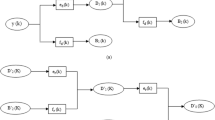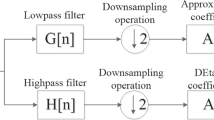Abstract
The explosive growth of digital imaging, especially in the fields of medicine, education, and e-commerce, has made data maintenance and transmission over networks a daunting task. Therefore, the development and use of image compression techniques have become vital for overcoming the problems of storage and transmission of digital image data. Two methods that are extensively used for data compression are Discrete Cosine Transformation and Discrete Wavelet Transform (DWT). In our present study, we have shown the benefits of a DWT-based approach by utilizing the canonical Huffman coding as an entropy encoder. DWT decomposes the image into different sub-bands. These sub bands are known as approximate image and detail images. The approximate image is normalized in the range (0, 1) for obtaining the Canonical Huffman coding bit stream. In a similar way, details coefficients are also normalized in the range (0, 1) for obtaining the canonical Huffman coding bit stream of detail images. Hard thresholding is often used to discard insignificant coefficients of detail images. Our proposed method takes less computing time and has a smaller codebook size than that of conventional Huffman coding. Moreover, the results show an improvement over Wavelet Scalar Quantization often used for image compression of fingerprints. We have applied our method to various popular images and obtained promising PSNR, CR, and BPP that highlight the advantages of our approach and the efficiency of our algorithms.










Similar content being viewed by others
References
Chiranjeevi, K., & Jena, U. R. (2016). Image compression based on vector quantization using cuckoo search optimization technique. Ain Shams Engineering Journal. https://doi.org/10.1016/j.asej.2016.09.009.
Latha, P. M., & Fathima, A. A. (2018). Collective compression of images using averaging and transform coding. Measurement. https://doi.org/10.1016/j.measurement.2018.12.035.
Patel R., Kumar V., Tyagi V., & Asthana V. (2016). A fast and improved image compression technique using huffman coding. In International conference on wireless communications, signal processing and networking (WiSPNET). (PP. 2283–2286), IEEE.
Almurib, H. A. F., Kumar, T. N., & Lombardi, F. (2017). Approximate DCT image compression using inexact computing. IEEE Transactions on Computers. https://doi.org/10.1109/TC.2017.2731770.
Matai J., Kim J.Y., Kastner R. (2014). Energy efficient canonical Huffman encoding, In 25th International conference on application specific systems, architecture and processors, zurich, switcherland (pp.202–209), IEEE.
Zhang, Y., Pei, Z., Yang, J., & Liang, Y. (2008). Canonical huffman code based full-text index. Progress in Natural Science., 18, 325–330.
Yuan, S., & Hu, J. (2019). Research on image compression technology based on Huffman coding. Journal of Visual Communication and Image Representation, 59, 33–38.
Singh, M., Kumar, S., Singh, S., et al. (2016). Various image compression techniques: lossy and Lossless. International Journal of Computers and Applications, 142(6), 23–26.
Hu, Y. C., & Chang, C. C. (2000). A new lossless compression scheme based on Huffman coding scheme for image compression. Signal Processing: Image Communication., 16(4), 367–372.
Arif, M., & Anand, R. S. (2014). Effect on speech compression by combined delta encoding and huffman coding scheme. Wireless Personal Communications, 79, 2371–2381.
Kasmeera, K. S., James, S. P., & Sreekumar, K. (2016). Efficient compression of secured images using subservient data and huffman coding. Procedia Technology., 25, 60–67.
Kasapbasi, M. C. (2019). A new chaotic image steganography technique based on huffman compression of turkishtexts and fractal encryption with post-quantum security. IEEE Access., 7, 148495–148510.
Yin, Z., Xiang, Y., & Zhang, X. (2019). Reversible data hiding in encrypted images based on multi-MSB prediction and huffman coding. IEEE Transactions on Multimedia., 22(4), 874–884.
Bradley JN, Brislawn CM, & Hopper T. (1993). The FBI wavelet/scalar quantization standard for gray-Scale Fingerprint Image Compression. Optical Engineering and Photonics in Aerospace Sensing, 1993, Orlando, FL, United States. https://doi.org/https://doi.org/10.1117/12.150973.
Hopper T. & Preston F. (1992). compression of gray-scale fingerprint images. In Proceedings Snowbird, Utah, (pp.309–318).
Khalifa, O. (2005). Wavelet coding design for image data compression. The International Arab Journal of Information Technology (IAJIT), 2(2), 118–128.
Bairagi, V. K., Sapkal, A. M., & Gaikwad, M. S. (2013). The role of transforms in image compression. Journal of the Institution of Engineers (India) Series B, 94(2), 135–140.
Farghaly, S. H., & Ismail, S. M. (2020). Floating-point discrete wavelet transform-based image compression on FPGA. International Journal of Electronics and Communications. https://doi.org/10.1016/j.aeue.2020.153363.
Ammah, P. N. T., & Owusu, E. (2019). Robust medical image compression based on wavelet transform and vector quantization. Informatics in Medicine Unlocked., 15(100183), 1–11.
Li, P., Hua, P., Gui, D., Niu, J., Pei, P., Zhang, J., & Krebs, P. (2020). A comparative analysis of artifice neural networks and wavelet hybrid approaches to long-term toxic heavy metal prediction. Nature research, Scientific Reports. https://doi.org/10.1038/s41598-020-70438-8.
Cheremkhin, P. A., & Kurbatova, E. A. (2019). Wavelet compression of off-axis digital holograms using real/ imaginary and amplitude/phase parts. Nature research, Scientific Reports. https://doi.org/10.1038/s41598-019-44119-0.
Kaur, A., Mishra, D., Jain, S., & Sarkar, M. (2018). Content driven on-chip compression and time efficient reconstruction for image sensor applications. IEEE Sensors Journal. https://doi.org/10.1109/JSEN.2018.2869849.
Benchikh S., & Corinthios M. (2011). A Hybrid Image Compression Technique Based on DWT and DCT Transforms. Advanced Infocom Technology (ICAIT 2011), (pp. 1–8), IEEE.
Braylants, T., Munteanu, A., & Schelkens, P. (2015). Wavelet based volumetric medical image compression. Signal Processing: Image Communication., 31, 112–133.
Cosman, P. C., Gray, R. M., & Olshen, R. A. (1994). Evaluating quality of compressed medical images: SNR, subjective rating, and diagnostic accuracy. Proceedings of the IEEE, 30, 857–865.
Yildirim, O., Tan, R. S., & Acharya, U. R. (2018). An efficient compression of ECG signals using deep convolutional autoencoders. Cognitive Systems Research, 52, 198–211.
Author information
Authors and Affiliations
Corresponding author
Additional information
Publisher's Note
Springer Nature remains neutral with regard to jurisdictional claims in published maps and institutional affiliations.
Rights and permissions
About this article
Cite this article
Ranjan, R. Canonical Huffman Coding Based Image Compression using Wavelet. Wireless Pers Commun 117, 2193–2206 (2021). https://doi.org/10.1007/s11277-020-07967-y
Accepted:
Published:
Issue Date:
DOI: https://doi.org/10.1007/s11277-020-07967-y




